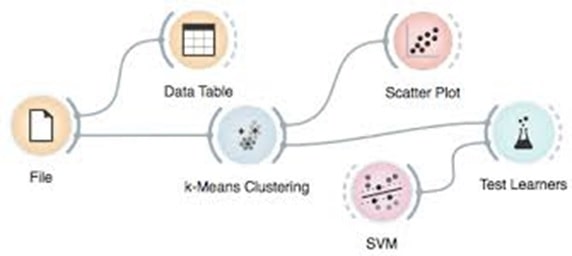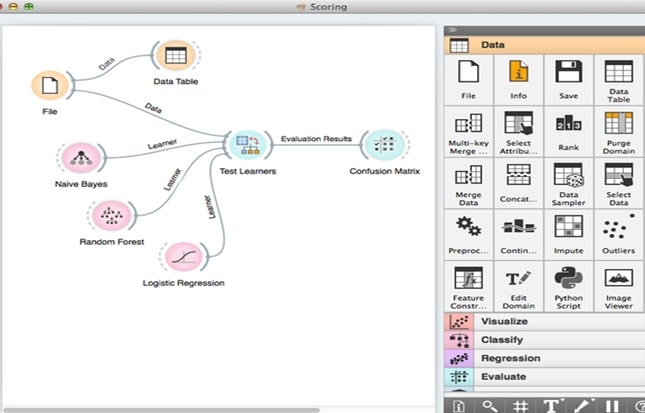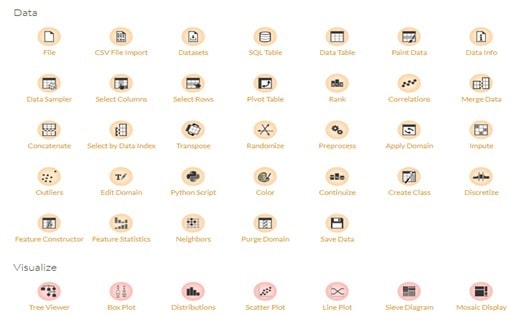Orange Data Mining Tool
Orange is an open-source data mining software or tool that is based on components or modules that can be used by novice and experts. Orange was developed by the University of Ljubljana. It has a range of techniques for visualizing, exploring, pre-processing, and modeling the data. Orange can be used as a nice intuitive graphical user interface or as a module for Python programming language for more advanced users.
Features of Orange software is:
- Orange is open-source data mining software; thus, it is possible to get its code and possibly modify it to the users’ requirements.
- Orange provides an interactive data visualization which allows the user to perform simple data analysis with a smart and clever way of data visualisation
- In Orange visual programming is possible as the GUI helps the user to focus or concentrate on exploratory data analysis than the coding.
- There are add-ons extend functionality present in Orange that helps in data mining from external data sources, performing text mining and other types of mining.
- Orange provides online support since Orange is an open-source software there is an online community that can provide support for solving queries on users.
- In Orange it is possible to create a dataset from any graph you want; in Orange, it is possible to have a reverse process option as it is possible to create a dataset using a graph that has been created.
Orange can be download on Windows, macOS and Linux. Depending on the system the user can download the following ways:
- Tool’s Installer (for Windows and macOS)
- Through Anaconda distribution (for all three systems)
- Through the pip (Python Package Index) module of Python (for all three systems)
- Install from source (for Linux)
For installing add-ons in Orange, the method is by finding the add-ons in the add-on manager. You can find an add-on manager in the Options menu of Orange software.
Orange Workflow and Canvas

In Orange Workflow it is possible to have and create a process for gaining more information on the data with ease of drag and drop of widgets in the canvas.
Some factors or reasons to use Orange Workflow are as follows:
- Through the processes and widgets, it is possible to identify where are misclassifications in the data set present by creating a workflow.
- It is possible to create a cross-validation workflow to test or check on how good are the data mining methods on the classification dataset.
- In the process of handling supervised problems and know the ranking of features in data, it is possible to create or use feature ranking
- It is possible to create a cluster inspection workflow in orange for the clusters created for the data by passing to a box plot and use the function order by relevance to know what the significance of the clusters is.
There is the possibility to create and use other workflows according to the user's requirements and needs. These processes can be created in multiple workflows or into a single workflow depending on the user's requirements and scenario of the project.
Steps to create a workflow
- Open Orange and click on New
- Add the details for the new workflow
- Add a file widget to add the data, to add data into the file widget double-click it and add the required data. The file data is generally the first widget that gets added as it is a widget that allows or gets access to the dataset.
- Add a different widget for example Data Table widget
- Link the file widget with other widgets, in case the Data Table widget. On the connection line, you should see something written on it to describe the relation or function creation between the two widgets. In this instance, Data should appear on the line.
- To confirm that the data is set in according to other widgets double click it. In this case, the data should be in a tabular format.
This process can be used for creating any kind of workflow required by the user.
Orange Canvas is a framework that is built as a graphical user interface for the ability to edit workflows. One of the components of the Orange Canvas is Orange Canvas Core. Orange Canvas is the visual programming environment for Orange. The Orange Canvas is part of the main Orange Repository, that allows working on the Orange Widgets to create an Orange Workflow.

Orange Widgets

Orange Widgets are components or modules in Orange Canvas, Orange's visual programming environment. The widgets represent some contain or have unique functionalities and provide a graphical user interface (GUI) of the functionality. Communication channels are used between widgets to communicate with each other and pass objects with one and other. There are about 150 widgets currently available to use from for the user.
Orange Widget has about 14 categories to choose for the user to choose from, and with each category, there are multiple widget options to which users can choose and select based on their requirements.
Some of the widget categories are as follows:
- Data: this widget category handles or has widgets related to data input, flittering, feature manipulation and selections etcetera.
- Visualize: the visualize category as the name states handle the widgets around visualisation of the data.
- Model: the model category contains or handles the widgets related to the supervised machine learning functionalities.
- Evaluate: this category contains or handles the widgets related to cross verification on the prediction made by the models.
- Unsupervised: this widget category contains or handles the widgets related to the unsupervised machine learning functionalities.
- Text Mining: this widget category is related to text mining and natural language processing.
- Image Analytics: this widget category works with the analysis of images.
- Time Series: this widget category is related to analysis and around time series.
There are basic requirements or functionalities that are required or performed by the widgets which are getting the input of data and providing outputs according to the widget functionality.
To add widgets onto the canvas there are 3 ways to do it:
- Double-click on the widget.
- Drag and drop the widget onto the canvas.
- Right-click on the canvas for the widget menu option to pop up.


